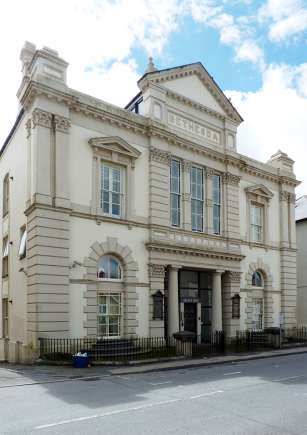Former Independent Chapel, High Street, Bethesda, Gwynedd
The town of Bethesda, which had previously been known as Glanogwen, took its name from the Congregationalist chapel built on the High Street around 1820-23 by the Welsh Independent nonconformists and named Bethesda, being Hebrew for House of Mercy. The chapel was enlarged and re-built in 1840 on a steeply sloping site providing two storeys to the street and four storeys to the rear. In 1872-1875 Richard Owens carried out further works including the building of a Classical façade and new chapel interior (now lost) while retaining the shell of the earlier rebuilding. However, the detailing, including a mixture of Corinthian pilasters and Tuscan columns, are perhaps indicative of Owens’ lack of formal architectural training in the Classical style. Nonetheless the composition shows a strong sense of theatre, a manifestation of the drama within.
The final service was held on 11 July 1988, after which the building fell into disrepair. In 1996, Gwynedd Council granted planning permission for the conversion of the building into 12 flats for the elderly. This North Wales Housing Association residential complex named Arafa Don, opened in 1998
TO BUILDERS. CONGREGITIONAL CHAPEL, BETHESDA. The Committee are prepared to receive Tenders for alterations to the above - principally, Joiner's Work. Plans and Specifications to be seen at 52, High-street, Bethesda and Tenders to be sent to the Rev. R. S. Williams, 3, Ogwen-terrace, Bethesda, on, or before the 10th day of February next. They do not bind themselves to accept the lowest or any tender. RICHD. OWENS, Architect, 2, Breck-road, Liverpool. [Y Tyst a’r Dydd 24 January 1873 page 12]
Reference Buildings of Wales: Gwynedd page 263
Reference Y Tyst a’r Dydd 24 January 1873 page 12
